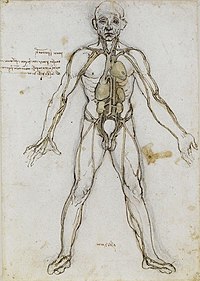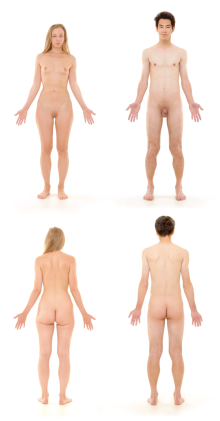
Back Mennisc līc ANG جسم الإنسان Arabic মানৱ শৰীৰ Assamese Cuerpu humanu AST ГӀадамасул черх AV İnsan bədəni Azerbaijani Lawas nin tawo BCL Цела чалавека Byelorussian Човешко тяло Bulgarian মানব দেহ Bengali/Bangla
 |
| Part of a series of lists about |
| Human anatomy |
|---|

The human body is the entire structure of a human being. It is composed of many different types of cells that together create tissues and subsequently organs and then organ systems.
The external human body consists of a head, hair, neck, torso (which includes the thorax and abdomen), genitals, arms, hands, legs, and feet. The internal human body includes organs, teeth, bones, muscle, tendons, ligaments, blood vessels and blood, lymphatic vessels and lymph.
The study of the human body includes anatomy, physiology, histology and embryology. The body varies anatomically in known ways. Physiology focuses on the systems and organs of the human body and their functions. Many systems and mechanisms interact in order to maintain homeostasis, with safe levels of substances such as sugar, iron, and oxygen in the blood.
The body is studied by health professionals, physiologists, anatomists, and artists to assist them in their work.